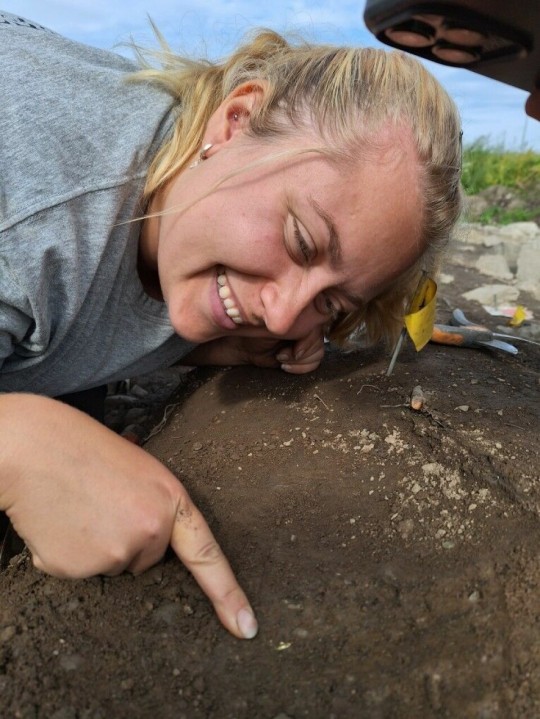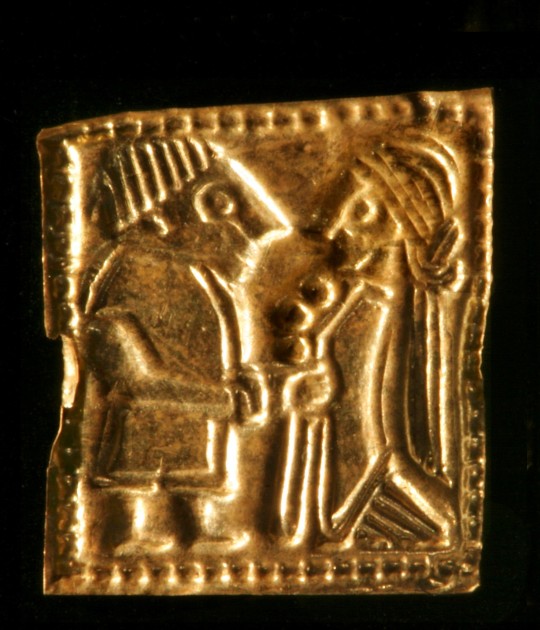#merovingian history
Explore tagged Tumblr posts
Text


Merovingian Gold and Garnet Fibula in the shape of a Rooster European · ca. 500 - 600 A.D.
#Merovingian Gold and Garnet Fibula in the shape of a Rooster#ca. 500 - 600 A.D.#gold#gold jewelry#ancient jewelry#ancient artifacts#archeology#archeolgst#history#history news#ancient history#ancient culture#ancient civilizations#the franks#merovingian history#ancient art
72 notes
·
View notes
Text
In the Histories, Brunhild and Fredegund appear as political adversaries and moral opposites. Gregory encouraged his audience to compare the two queens by emphasising their differences. He said nothing bad of Brunhild, yet he accused Fredegund of a great many crimes, including murder, sacrilege, witchcraft, and treason.
[...] Looking beyond Gregory’s interpretation, Brunhild and Fredegund may not have been so different. Both queens reigned at the side of their husbands and then remained politically influential during their widowhood as mothers of their minor sons. Both formed close, politically useful relationships with some bishops and quarrelled with others. Both cared about the education of their children and made efforts to rescue daughters who fell into the hands of rival powers. They treated their inferiors in a manner befitting a ruler, defending honour and threatening violence much as did kings and other powerful men. Their skilful evocation of both fear and love would have made Machiavelli blush. They donated to the church, venerated the saints, and kept an eye on those who might use illegitimate sources of spiritual power, such as witchcraft or poison, with due attention. Other sources recognised this fundamental similarity: Venantius Fortunatus, ever the dutiful royal client, praised Fredegund and Brunhild alike, while the Chronicles of Fredegar, written from the safety of a later generation, criticised them equally. Yet Gregory insisted they were rivals and moral opposites. His task was not an easy one. Rumours of Fredegund’s misdeeds may have abounded, but stories of Brunhild’s virtues were rather more obscure. Thus, Gregory carefully arranged his material, encouraging his audience to compare the two and to find Brunhild to be the better. Why so complex a narrative strategy? Gregory laboured under burdensome constraints, coming into personal conflict with Fredegund, while finding Brunhild to be a powerful, if intimidating, patron.
— E.T. Dailey, Queens, Consorts, Concubines: Gregory of Tours and the Women of the Merovingian Elite
#historicwomendaily#merovingian period#fredegund#brunehilde#brunhild#gregory of tours#women in history#french history#fredegund regina#6th century#merovingian history#queue#my post
15 notes
·
View notes
Text

Gold bractate, Merovinginan, 6th century
from The State Museums of Berlin
130 notes
·
View notes
Text

View of Reims Cathedral by Domenico Quaglio the Younger
#domenico quaglio the younger#art#notre dame de reims#reims cathedral#cathedral#cathedrals#france#french#medieval#middle ages#architecture#merovingian#church#churches#christian#christianity#europe#european#gothic#high gothic#history#reims
175 notes
·
View notes
Text
Cabochon finger ring

This stunning finger ring is decorated with dark glass paste, rather than a semi-precious stone. The simplicity of the ring indicates that it is Carolingian rather than Merovingian. The Carolingians embraced Catholicism on a much broader scale with the top-down process of baptism/religious conversion having reached the middle and even some of the lower classes.
This results in more minimalistic dress. Jewelry becomes very minimal and brooches that were included into ones appearance were once again reduced to their functional level. A finger ring like this does not proof that the wearer was in fact no longer pagan, but it does show that the wearer followed the fashion of the (Catholic) elite. Wearing finger rings also indicates that the wearer performed little to no physical labour as it risks damaging the jewel and it is also a means to show your wellbeing to the world.
The metropolitan museum of art, New York City - United States of America
Museum nr. 17.192.217
Found in Northern France (7th century)
#archaeology#carolingian#charlemagne#field archaeology#viking archaeology#viking mythology#merovingian#merovingian archaeology#frankish#germanic mythology#norse mythology#anglo saxon#viking#field archaeologist#frisian#odin#vikings#germanic#germanic folklore#germanic archaeology#wodan#anglo saxon archaeology#history#jewelry#norse#pagan tumblr#pagan
147 notes
·
View notes
Text
So I might’ve actually lectured my lecturer. He’s an archivist, but not a historian (in the broadest version of the word).
Previously mentioned: Roman archives, didn’t really survive because of wax tablets and papyri decaying but we know they wrote and archived. Sure.
After the disappearance of the Western Roman Empire (he was very safe with his word choices here), archiving or writing large amounts of texts wasn’t really a thing, until the Arabs came by the 12th century and Europe was archiving again.
HOLD THE FFING PHONE RIGHT THERE! And I did ask why he was reasoning this way. He didn’t really got me immediately so I provided him with examples.
Roman law didn’t disappear, it was held up and added upon. (Fine = income!) we know this because A) we have catholic additions on it making pagan elements in society illegal, B) we have written versions of the Lex Salica as old as the 8th century, C) Carolingian Minuskel is a thing, learned how to read it at previous Uni.
They just continued copying/translating Greek to Latin to f.e. Diets.
Laws are only useful when you have an institute that has them, can check on them and execute them. All those laws are stored somewhere (= archived).
Handy for cloisters to know how many properties they have and what they provide in income and how much they cost.
Roman law became regional, the Goths, Salic Franks, Anglians all had written law. The Catholic Church even invited Irish monks over to baptize Europeans and they introduced the space in written language in the process to make it easier for them. Writing… archiving…
The Catholic Church was very keen on making martyrs immediate saints. Their stories were recorded (!) into hagiographies. We still have those. They were kept (archived!) in churches and cloisters.
They like their heroes. Tales like Beowulf are 8th century. The church wrote their hymns down so they could hand it out to their singers. The church provided education. The male elite could write…
Gregorius of Tours wrote his Historia Francorum. He wrote the history of the Francs, while they were still around! That’s archiving!
Yeah sure, they wrote how the Vikings were invaders and so on and on. But they wrote it down in the cloister archives!
I mean I can continue. But these were the things I mentioned in class.
To clarify, the Arabs did not re-introduce the production of archiving material and archives themself. They were just never gone. What the Arabs did do was re-introduced science! (Scream it out loud for the people in the back!). While Charlemagne was busy killing Slavs, the Arabs had libraries (Baghdad House of Wisdom) and research institutes and were good mathematicians and astronomers (many stars in our night sky have Arab names to this day). Europe owes a ton of stuff thanks to the Islamic Golden Age. But not really recording and archiving.
On the other hand, I was later informed that the lecturer started panicking because i apparently cornered him good. I just took the one time I get to prove that the last five years of me working around the Early Middle Ages wasn’t for nothing. I don’t want to apologise
#archaeology#history#field archaeologist#geology#archaeologist#anthropology#art#baghad house of wisdom#house of wisdom#Baghdad#islamic golden age#Charlemagne#merovingian#frankish history#Salic franks#goths#Gregory of Tours#hagiography
46 notes
·
View notes
Text










Medieval Women Week || free day! ↬ Saint Radegund
Long before she founded her convent in Poitiers, Radegund expected to live out her days as a queen. She was born into the royal house of the Kingdom of Thuringia, in what is today central Germany. The precise year of her birth, as with so many events in her life, cannot be determined with certainty, but it fell in either the late 510s or, more likely, the early 520s. While she was still very young, Radegund lost both of her parents. Yet this tragedy was soon eclipsed by the downfall of her dynasty, and the slaughter of most members of her family, following an invasion by the Franks in 531. King Chlothar I took Radegund as his captive and later made her his bride. For several years, the young Radegund reigned as queen alongside the very man who had butchered many of her relatives, until Chlothar went one step further and caused her surviving brother to be killed. Following this unforgivable crime, Radegund took religious vows and, after living for a few years in a villa, she founded her grand convent in Poitiers during the 550s. There she remained, in pious devotion and ascetic self- denial, until her death in 587 (outliving Chlothar by more than a quarter century). In what might be considered her greatest single achievement, she obtained from the imperial court in Constantinople what were thought to be fragments of the ‘True Cross’, the wood used to crucify Jesus on the hill of Golgotha in Jerusalem. Facing down opposition from her local bishop, Radegund managed to have the relic placed within her convent, which subsequently acquired the name of ‘Holy Cross.’ — Radegund: The Trials and Triumphs of a Merovingian Queen by E.T. Dailey
#medievalwomenweek#radegund of poitiers#merovingians#french history#german history#european history#medieval#history#nanshe's graphics
48 notes
·
View notes
Text


Brunhild could not help but be unmoored; her rival had been the one constant in the ever-shifting political waters. Fredegund’s actions had informed her own for the past thirty years. She had grown so used to trying to anticipate Fredegund’s next plot; it would have felt strange to drift to sleep without that worry. Brunhild also felt her age. Nearly every royal, bishop and duke she had worked with or against was gone, replaced by their own children, or by a new family altogether. Brunhild’s political activities in the aftermath of Fredegund’s death were strangely civil. She launched no attacks on Neustria, not even to take back the recently conquered territories. It is unclear whether that was due to bad advice by her military advisers or if Brunhild herself decided to allow Neustria to mourn its queen in peace. But Brunhild could afford to be magnanimous.
Shelley Puhak, The Dark Queens: A gripping tale of power, ambition and murderous rivalry in early medieval
#brunhilde#brunhild#brunhilda#brunegilda#brunequilda#fredegund#french history#women in history#merovingians
49 notes
·
View notes
Text

Hello all, and welcome to my historical women inktober! I’ve started with a few mythological women and then included at least one from each century from 100 BCE - 1500 CE; however, there are seven specifically from the 11th century because that is my favorite century. I may be the only one following this list, but if anyone else decides to give it a try, tag me on instagram or tumblr, and use the hashtag #grayjoytober2024 !
.
Leave a comment or dm me if there are any questions about the ladies. I’d be happy to clarify! I tried to include names that would be easy to find via google search.
#grayjoytober2024#historical women#history art#greek mythology#trojan war#argonauts#digital art#roman empire#byzantine empire#medieval wales#medieval england#kyivan rus#merovingian#inktober#inktober prompts#inktober 2024#drawtober 2024
8 notes
·
View notes
Text


Some Dieudonnés
Putting these 2 illustrations next to each other, since I liked the style I used for this! Finally got better at drawing veils and patterns which is nice
#philip augustus#philip ii of france#louis vii of france#adela of champagne#adele de champagne#henry the young king#philip of alsace#philip count of flanders#isabella of hainault#isabelle de hainaut#12th century#medieval#historical illustration#french history#my art#best worst annoying boy#merovingian swag
47 notes
·
View notes
Text

1400-Year-Old Gold Foil Figures Found at Pagan Temple in Norway
Archaeologists have discovered a votive gold hoard during road development works in Vingrom, south of Lillehammer on the shores of Lake Mjøsa Norway.
The 5 gold pieces are tiny, about the size of a fingernail. They are flat and thin as paper, often square, and stamped with a motif. Usually, they depict a man and a woman in various types of clothing, jewelry, and hairstyles.
The objects were discovered in the remains of a pagan temple, where previous excavations have uncovered thirty similar stamped gold objects in the vicinity over the past three decades.
Archaeologist Kathrine Stene was the project leader for the excavation, which has been ongoing along the road here all summer and into autumn, due to the upgrade of the E6 highway between Mjøsa Bridge and Lillehammer.
“It was incredibly exciting,” Kathrine Stene said.



The pagan temple measures around fifteen meters in length. Archaeologists have found five gold foil figures in the last couple of weeks.
According to the researchers, the objects date from the Merovingian era sometime between AD 550 to the Viking Age.
The latest objects were found beneath the structure in the wall runs and in adjacent postholes, suggesting that they were ritually placed as votive offerings in the form of a sacrifice or a religious act to protect the building before it was constructed.
In 1993, the temple at Hov was discovered entirely by chance. County conservator Harald Jacobsen noticed the soil while driving along the E6. He thought it looked like what archaeologists call cultural layers, or soil containing human traces. A quick investigation proved him correct, and the discovery of two gold foil figures indicated that this was no ordinary location.


Smaller excavations during the 2000s led to the discovery of 28 gold foil figures, and what is referred to as a temple, a house for pagan religious practices.
In Norway, findings of gold foil figures are rare. The 35 from the temple in Vingrom represent the largest collection found in this country.
However, 100 gold foil figures were found in a similar temple at Uppåkra in Sweden, and more than 2,500 gold foil figures were found in a field on the Danish island of Bornholm.
So, “There must be more of them here,” researchers believe.
By Oguz Kayra.


#1400-Year-Old Gold Foil Figures Found at Pagan Temple in Norway#Lake Mjøsa Norway#temple at Hov#treasure#gold#gold foil#ancient artifacts#archeology#archeolgst#history#history news#ancient history#ancient culture#ancient civilizations#ancient art#Merovingian era#viking era
347 notes
·
View notes
Text
Angelberga was a peculiarly prominent personality in manifold aspects of European politics [in the late 9th century. Born to the Supponid family of Italy, she married Emperor Louis II and had several opportunities to establish her position as an active and controversial player in the vicissitudes of her husband's reign]. She acted as Louis's regent, accompanied him on expansionary military campaigns in the south of the peninsula and represented him at [congresses, tribunals, and diplomatic negotiations]. Strikingly, she was also the beneficiary of a spectacular collection of charters. Almost one in seven of Louis II’s extant charters were issued in her favour. Angelberga’s conspicuous exploits in the field of charter acquisition did not diminish after the emperor’s death, and this helped her to maintain a position as a key power-broker in Italian politics, control of land [particularly monastic foundations] being a fundamental building-block of power in this period. In the interregnum following 875, during which Charles the Bald of West Francia and Karlmann of Bavaria fought to claim the succession to the heirless Louis, Angelberga herself conducted the negotiations and decided the loyalty of a major sector of the Lombard political community. She maintained this high profile until her death [having supported her son-in-law Boso's quest for power, endured a temporary exile, maintained the support of Pope John VIII, and founded the monastery of San Sisto in the city of Piacenza, where she probably ended her days sometime before 891].
— Simon MacLean, "Queenship, nunneries and royal widowhood in Carolingian Europe"
#historicwomendaily#angelberga#Louis II of Italy#Italian history#Carolingian period#9th century#my post#Angelberga is wildly fascinating to me#She's been described by numerous historians as 'the most openly powerful of the Carolingian royal wives' (Fiona M. MacFarlane)#'The first Carolingian royal woman to take a fully public role in government' (Phyllis G. Jestice) etc#In many ways this is dependent on the Carolingian paradigm of royalty which differed from its Merovingian predecessors#and which saw queens conducting their activities on a primarily domestic/spatial level#with significantly reduced indicators of autonomy and oddly obscured importance/influence in contemporary sources#(That didn't necessarily mean a reduction in importance - just a shift in what that importance actually meant and should contribute to)#In that framework Angelberga's wide-ranging public activities do seem to have been the 'exception'#It's all the more notable considering the fact that she never had a son#Which is yet another thing I find very interesting with her - how her lack of a son affected various spheres and events of her life#Predictably contemporaries and chronicles viewed her as a controversial figure who was arrogant and insolent and sexually transgressive#(shocker)#also her name has many spelling variants in sources and history books - I'm using Angelberga to make it consistent#and because it was how La Rocca (the first historian whose work of her I read) referred to her
25 notes
·
View notes
Text


Gold and jewel mounted sword, Merovingian, 5th-6th century AD
from Christies
142 notes
·
View notes
Text

The Education of the Children of Clovis (School of Vengeance, Training of Clotilde's Sons)
by Lawrence Alma-Tadema
#lawrence alma tadema#art#clovis#clotilde#sons#franks#frankish#merovingian#ancien régime#gaul#france#french#germanic#history#training#europe#european#medieval#middle ages#axe#monarchy#royalty#royal#royals#nobility
132 notes
·
View notes
Text
The Langobards

The Langobards/Lombards/Longobards are an Italic-Germanic tribe with origins in southern Scandinavia around the first centuries B.C. and A.D.
Their steady migration southward can be retraced by archaeological artifacts, which show their Scandinavian origin.
Their early connections to (the geographical city of) Rome made them very influential in the Western Roman world; on financial, military, religious but also law practice and kingship levels.
The Lombards were quickly christened and were the founding fathers of many religious institutions in northern Italy, ruled Italy, and adapted/adopted Roman Law, making for a culturally rich period. Their capital Pavia is located in the Italian province of Lombardy, named after, you guessed it.
It has to be said (it sounds like a fake fact but it is not) that their name means “Long Beards”. In many European languages the descriptive name can be heard in “Langobard” also written as “Longobard”.
Image:
Langobardic radiate headed bow brooch
Found in: Chiusi - Tuscany, Italy
#frankish#merovingian#viking archaeology#archaeology#carolingian#charlemagne#field archaeology#viking mythology#merovingian archaeology#germanic mythology#lombards#Lombardi#lombardia#Lombardic#longobardi#Langobards#norse mythology#anglo saxon#field archaeologist#viking#frisian#odin#vikings#germanic#germanic folklore#germanic archaeology#wodan#anglo saxon archaeology#history#jewelry
176 notes
·
View notes